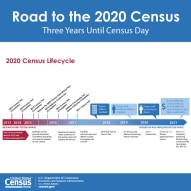For Immediate Release: Friday, March 31, 2017
"Three Years to Go, Census Bureau Prepares for 2020 Census"
MARCH 31, 2017 — Three years away from Census Day, April 1, 2020, the U.S. Census Bureau continues to leverage years of research to prepare for a complete and accurate census. This census will be the most technologically advanced and automated census ever.
The 2017 Census Test is underway, testing the integration of operations and systems for households to respond via the internet (in addition to telephone and paper).
In addition, the Local Update of Census Addresses operation for the 2020 Census has begun. With more than 140 million housing units across the country by 2020, this operation is a way for tribal, state and local governments to review and comment on the Census Bureau’s address list for their jurisdiction prior to the 2020 Census. Participation in this operation helps ensure an accurate decennial census count for their communities.
This week, the Census Bureau delivered its planned subjects for the 2020 Census and the American Community Survey to Congress, which include gender, age, race, ethnicity, relationship and homeownership status. By law, the Census Bureau must deliver the subjects to Congress three years before Census Day. The subjects represent the established federal needs for the data. The actual wording of the questions that will appear on the 2020 Census questionnaire must be submitted to Congress by March 31, 2018.
Road to the 2020 Census
The goal of the 2020 Census is to count everyone once, only once and in the right place. The Census Bureau is using expert resources and experience in and out of the government to make the 2020 Census a success. As census operations and testing move forward, the Census Bureau will continue to improve its use of mobile technology, administrative records, innovations from the geospatial industry, and self-response via the internet.
The Census Bureau has already conducted extensive research and testing:
- The 2013, 2014 and 2015 Census Tests across the country studied a wide range of topics — from race and ethnicity questions to automating field operations to internet self-response. The results were critical in forming the 2020 Census Operational Plan.
- The 2016 Census Test refined many of the innovative and cost-saving procedures and methods documented in the operational plan. We focused on finalizing methods for field automation and using administrative records and third-party data to reach households that do not respond to the census.
We have two significant tests ahead of us:
- The 2017 Census Test, currently underway, will allow the Census Bureau to assess the integration of operations and systems needed for households to respond to the census online in advance of the 2020 Census. The test also includes telephone and traditional paper questionnaire response options.
- Research, testing and IT system development are on schedule for the critically important 2018 End-to-End Census Test. This is the final large-scale test of operations before conducting the 2020 Census.
Looking Ahead to 2020
- The decennial census, which is mandated by the Constitution and has been conducted every 10 years since 1790, is a record of population and housing through which everyone is counted once, only once and in the right place. The results are then shared with the president, the states and the American people.
- Census data are used by government entities for redistricting, such as defining the representative boundaries for congressional and state legislative districts, school districts and voting precincts.
- Census data are also used by other agencies to distribute hundreds of millions of dollars in federal funds each year for roads, schools, fire departments and other critical infrastructure investments.
- Census data provide the sample selection framework for the American Community Survey that produces statistical data needed by local communities. It is also used to calculate monthly unemployment, crime and poverty rates, and health and education statistics.
- Census data play an increasingly important role in U.S. commerce and the economy by helping people make decisions at the local and national level based on topics like population growth and income levels.
No news release associated with this report. Tip Sheet only.
-X-





